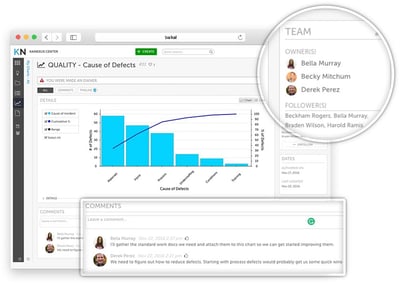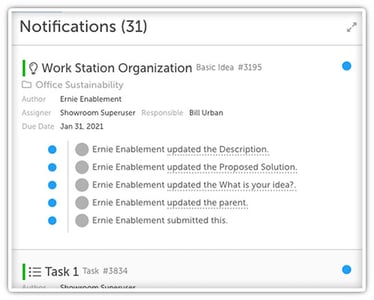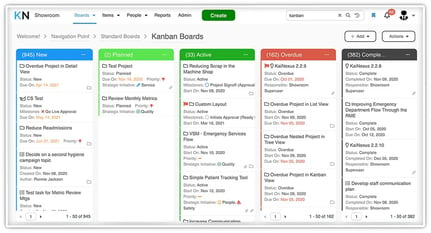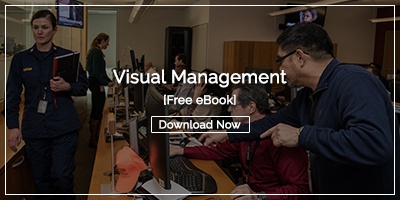 According to research generated by 3M, the company that brought you Post-it Notes, visual information is processed 60,000 times faster than text. Visionary leaders take advantage of the human mind's ability to process and remember visuals and leverage it to get more from all of the continuous improvement practices they manage.
According to research generated by 3M, the company that brought you Post-it Notes, visual information is processed 60,000 times faster than text. Visionary leaders take advantage of the human mind's ability to process and remember visuals and leverage it to get more from all of the continuous improvement practices they manage.
Managers and supervisors can use visual management to support a culture of improvement and spread success across the organization. Opting for the digital approach makes it possible to deploy an improvement management system that makes visualization easy and available for every employee.
The Benefits of Visual Management Software
Early Insight
In a culture of improvement, visual management software enables leaders to become aware of problems and challenges early. Instead of being blindsided by problems, energy can be devoted to addressing issues before they become a big deal.
Real-Time Data
The best digital visual management technology offers information in real-time. There is no lag between when a problem is reported and when people are made aware of it. Automatic dashboard updates make it possible for managers and supervisors to address minor issues before they become big ones. It also reduces the headaches associated with multiple versions of spreadsheets or endless emails. With online digital management, there is one common version of the truth.
Access from Anywhere, Any Time
Daily huddle (or stand-up) meetings are a widespread practice in which team members gather around a board that tracks projects. The improvement plan for the day is discussed. The limitation is that workers must be present to participate, and leaders who manage multiple teams must walk from place to place or even visit more than one location to get a sense of how much progress is being made. With a cloud-based solution, people can actively participate in daily meetings even if they are not in the office, a critical need following the recent move to remote work due to the pandemic. Leaders can keep up with as many teams as needed without spending their time roaming the halls.
Increased Engagement
Most people are open to engaging in improvement, but it can be challenging to make it a focus when other priorities come into play. That's why visual management software with workflow, including alerts and notifications, creates an advantage. The solution pulls attention back to the matter and alerts the necessary people when new tasks are added, or due dates are missed.
Support for Continuous Improvement Culture
Creating visibility into improvement efforts and demonstrating the willingness to invest in them send a clear signal that continuous improvement isn't just a passing leadership fad. Improvement software creates a common language around positive change and reinforces the behaviors and practices necessary to reach breakthrough goals.
Visual Management Techniques
Some particular improvement techniques are ideally suited for digital visual management.
Huddle Boards
We mentioned daily huddles earlier. Physical huddle boards once served the vital purpose of visualizing the progress of improvement projects. At specified intervals, employees gather to discuss opportunities for positive change and work together to remove any roadblocks to improvement. In concept, physical huddle boards have a lot going for them. They visualize progress, promote collaboration, and place a focus on improvement. Unfortunately, they are only a snapshot in time. Digital boards, on the other hand, are available to everyone, capture the history of each improvement, and actively remind people when they need to take action.
Kanban Boards
Kanban is a visual management technique that illustrates the flow of work. Kanban means it translates to "signboard" or "visual signage" in Japanese. A Kanban board can depict any work that flows from one stage to another. For example, a software team might show work moving from requirements development through testing and deployment. The goal is to make any interruptions to the flow or excess work-in-progress obvious. Software-based Kanban boards provide real-time updates, ensuring that decisions are made based on the latest information.

Gemba Walks
A Gemba walk is the practice of going to the place where work is done to show respect and observe. While it is not a chart or board, Gemba walks are an excellent example of visual management. Improvement software makes Gemba walks more effective by providing a repository for observations and a structured way of analyzing and implementing changes.
Strategy Deployment
One of the essential responsibilities of leaders is aligning the organization with the most critical strategic goals. It is important that the goals be well communicated and that each person understands how their work contributes to the team's success. Digital visual management helps leaders manage goals and progress.
![[WEBINAR] Strategy Deployment Software Demo](https://no-cache.hubspot.com/cta/default/326641/67b72769-975a-48b1-b5d8-4ba0fe1f3b76.png)
Organizations that leverage a visual approach to improvement experience more completed projects, faster cycle times, and increased employee engagement. These advantages are well worth the investment and effort.



Add a Comment